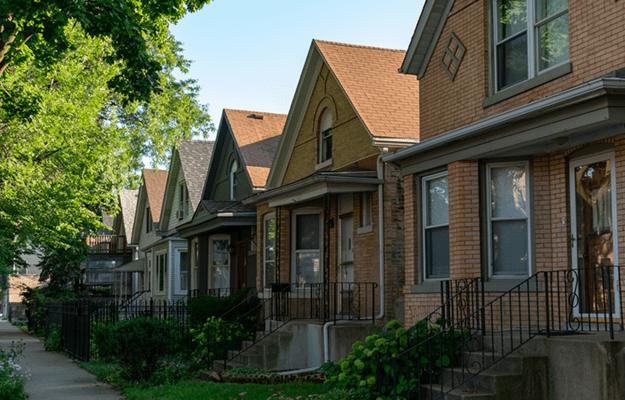
(Thomas H. Mitchell/Getty Images)
Five Principles Landlords Can Follow to Take a More Active Role in Preventing Evictions
This post was originally published on Urban Wire, the blog of the Urban Institute.
During the COVID-19 pandemic and resulting economic crisis, government protections and assistance were enacted to help stabilize millions of families and keep people in their homes. But as the pandemic has waned, so have these renter protections, leading to a rise of evictions in many communities. Without further interventions, we risk returning to the prepandemic status quo of almost a million evictions per year or risking potentially more dire conditions.
Last week, the White House published a Blueprint for a Renters Bill of Rights, which outlines strategies for the federal government, state and local partners, and the private sector to strengthen tenant protections and encourage rental affordability. Although government and business leaders play an important role in helping tenants stay stable and safe, property owners and operators are also a key player in eviction prevention. So far, however, there has been little study of the link between tenant outcomes and specific property management practices.
To fill this knowledge gap, the Urban Institute and Enterprise Community Partners, with the support of Stewards of Affordable Housing for the Future and the Housing Partnership Network, convened a group of mission-aligned owners and operators of rental properties to better understand the landscape of practices they’ve adopted to reduce the occurrence and effects of eviction. We identified a set of principles and practices that can guide property owners and operators on how to prevent and mitigate evictions for their tenants.
How property owners and operators can strengthen tenant stability
Before the COVID-19 pandemic, around 3.6 million evictions were filed annually, often over menial sums. Black, Latinx, and women renters were more likely to be evicted, which often led to poor health, financial, and housing outcomes. To begin to address these negative outcomes and offer a starting point for action, we outline five principles and the related practices that rental owners and operators can take to improve tenant stability (link added February 2, 2023).
- Remove barriers for tenants in their housing search and use transparent processes when establishing tenancy. Even in the early stages of a new tenant relationship, owners and operators can implement practices that lay the groundwork to prevent evictions. For one, owners and operators can ensure their tenant screening practices are fair, equitable, and relevant to housing outcomes. Owners and operators can provide transparency in their leases, including education and outreach around the terms of residency, housing rights, reasonable accommodations, and other available resources. With shorter, clearer leases, owners and operators can begin their relationship on more equitable footing. Finally, just-cause eviction policies can prevent tenant removal for arbitrary, retaliatory, or discriminatory reasons.
- Use clear, accessible, and equitable communication through all stages of tenancy. Through frequent, proactive, and culturally sensitive communication, owners and tenants can build trusting relations and take steps to mitigate their risk of eviction before tenants fall behind on rent. By using trauma-informed methods of communication, owners and operators can foster more connected and trusting relationships.
- Proactively connect tenants to resources and encourage communities of support. As many owners and operators learned during the pandemic, external partnerships with service providers and community organizations, including financial counseling, food assistance, health care, and eviction diversion programs, are key to stabilizing renters and providing better outcomes for all parties. Owners and operators can also build support networks and strengthen tenant relationships within the property.
- Allow flexibility in terms, processes, and payments for renters to reduce the likelihood of eviction. A rental housing owner who has implemented practices to proactively monitor the risk of nonpayment and regularly engages with residents may be able to identify and help prevent a nonpayment issue before it occurs. Owners and operators can then allow lease modifications to promote flexibility and can provide sufficient notice of intent to file to give tenants adequate time to rectify lease violations.
- Commit to procedures that prioritize eviction diversion in the case of non-payment or late payment. Even after an eviction is filed, owners still have an opportunity to reach more favorable outcomes. They can engage in mediation to reach a compromise or offer mutual rescission and early lease termination to provide alternative options to a formal eviction judgement.
Moving toward more comprehensive eviction prevention strategies
Although these principles were designed with collaboration from mission-driven owners, they can also serve as a starting point for other rental housing owners and operators, including private owners and public housing authorities. The White House’s Renters Bill of Rights also includes actions, such as regulatory reforms to improve the quality of tenant screening and background checks, that will advance the principles in our report.
Owners are a critical actor to prevent evictions, but they also need supports from the legal system, policymakers, and investors to improve outcomes. Particularly as rental housing owners aim to both meet their financial obligations and commit to eviction prevention. Expanding federal housing assistance, offering more supportive services grants for rental owners, creating options for mediation in local court systems, and enacting other policies can ensure every low-income household has available financial support and options for recourse to avoid eviction.


